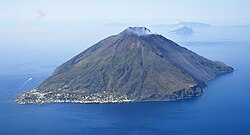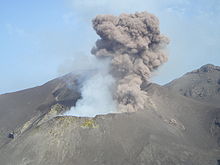Stromboli
Stromboli
| |
|---|---|
Island | |
 Aerial view of Stromboli from the northeast; to the right, the Sciara del Fuoco can be seen. | |
| Coordinates: 38°47′38″N 15°12′40″E / 38.79389°N 15.21111°E | |
| Country | Italy |
| Island grouping | Aeolian Islands |
| Region | Sicily |
| Area | |
| • Total | 12.6 km2 (4.9 sq mi) |
| Elevation | 924 m (3,031 ft) |
| Population (2016) | 500[2] |

Stromboli (/ˈstrɒmbəli/ STROM-bə-lee, Italian: [ˈstromboli]; Sicilian: Struògnuli [ˈʂː(ɽ)wɔɲɲʊlɪ]) is an island in the Tyrrhenian Sea, off the north coast of Sicily, containing Mount Stromboli, one of the four active volcanoes in Italy. It is one of the seven Aeolian Islands, a volcanic arc north of Sicily, and the mythological home of Aeolus.[3]
The island, with an area of 12.6 square kilometres (4.9 sq mi),[4] represents the upper third of the volcano.[5] Its population was about 500 as of 2016[update].[2] The volcano has erupted many times and is constantly active with minor eruptions, often visible from many points on the island and from the surrounding sea, giving rise to the island's nickname "Lighthouse of the Mediterranean".[6]
Etymology
[edit]The name Stromboli is derived from the Ancient Greek name Strongýlē, (Στρογγύλη) which was derived from στρογγύλος (strongýlos, 'round'), after the volcano's round, conical appearance when seen from a distance.[7][8]
Height and shape
[edit]Stromboli stands 926 metres (3,038 ft) above sea level,[9] and over 2,700 metres (8,900 ft) above the sea floor.[5]
The area of Stromboli island is 12.6 square kilometres (4.9 sq mi).[4]
As of June 2024, there are two active craters at the peak, each with multiple vents showing volcanic activity and lava flows.[10]
The Sciara del Fuoco ("stream of fire") is a big horseshoe-shaped depression created in the last 13,000 years by several collapses on the northwestern side of the cone. Approximately 2 kilometres (1+1⁄4 miles) northeast lies Strombolicchio, the volcanic plug remnant of the original volcano.
Volcano
[edit]
Mount Stromboli has been in almost continuous eruption for the past 2,000–5,000 years;[6] its last serious one occurred in 1921.[4] A pattern of eruption is maintained in which explosions occur at the summit craters, with mild to moderate eruptions of incandescent volcanic bombs, a type of tephra, at intervals ranging from minutes to hours. This pattern of Strombolian eruption, as it is known, is also observed at other volcanoes worldwide.
Eruptions from the summit craters typically result in a few short, mild, but energetic bursts, ranging up to a few hundred meters in height, containing ash, incandescent lava fragments, and stone blocks. Stromboli's activity is almost exclusively explosive, but lava flows do occur at times when volcanic activity is high: an effusive eruption occurred in 2002, the first in 17 years, and again in 2003, 2007, and 2013–14. Volcanic gas emissions from this volcano are measured by a multi-component gas analyzer system, which detects pre-eruptive degassing of rising magma, improving prediction of volcanic activity.[11]
On 3 July 2019, two major explosive events occurred at around 16:46 local time, alongside 20 additional minor explosive events identified by Italy's National Institute of Geophysics and Volcanology. A hiker near the volcano's summit died after being struck by flying debris when the eruption began.[12][13][14] Additionally, 6 people suffered minor injuries due to the eruption.[15]
On 28 August 2019, at 10:16 local time, an explosive eruption sent a pyroclastic flow down the volcano's northern flank and into the sea, where it continued for several hundred meters before collapsing. The resulting ash column reached a height of 2,000 m (6,600 ft).[16]
On 4 July 2024, Stromboli erupted along with Etna, as Protezione Civile issued the highest alert level.[17][18]
Settlements
[edit]
Two villages, San Bartolo and San Vincenzo, lie in the northeast, while the smaller village Ginostra lies in the southwest.[19] Administratively, they are one of the frazioni (unit of a commune and municipality) of Lipari, Messina.
In the early 20th century, a few thousand people inhabited the island,[20] but after several waves of emigration, the population has numbered a few hundred since the mid-1950s.[21] The population on the island was about 500 as of 2016[update].[2]
In addition to Italian, a derivative of the Sicilian dialect that is called Aeolian is generally spoken on this and the other Aeolian islands.[22]
In popular culture
[edit]- In Journey to the Center of the Earth (1864) by Jules Verne, the conclusion of the novel is set on Stromboli.
- Author J. R. R. Tolkien identified his fictional volcano Mount Doom in Mordor with the volcano of Stromboli, according to scholar Clyde S. Kilby.[23]
- Stromboli (1950), also known as Stromboli, Land of God, is an Italian-American film set on Stromboli, directed by Roberto Rossellini and starring Ingrid Bergman.
- Rising Appalachia's 2015 song "Stromboli" was written on and titled after the island. The studio version appears on Wider Circles (2015), and a live version appears on Alive.[24]
- An Italian-American savory pastry is named stromboli after the island.
- The fiction thriller novel titled "The Book Of The Dead" features the island as part of its conclusion. The novel is written by Douglas Preston and Lincoln Child.
See also
[edit]References
[edit]- ^ "Stromboli, Italy". Peakbagger.com. Retrieved 20 July 2013.
- ^ a b c "Isola di Stromboli" [Stromboli Island] (in Italian). Comune di Lipari. Retrieved 25 February 2016.
- ^ Strabo (1903) [1877]. Meineke, A. (ed.). "The Geography of Strabo". Translated by Hamilton, H.C.; Falconer, W. Leipzig: Teubner – via Perseus Digital Library.
- ^ a b c Tikkanen, Amy. "Stromboli Island, Italy". Encyclopedia Britannica. Retrieved 5 May 2021.
- ^ a b Tibaldi, A.; Corazzato, C.; Marani, M.; Gamberi, F. (2009). "Subaerial-submarine evidence of structures feeding magma to Stromboli Volcano, Italy, and relations with edifice flank failure and creep". Tectonophysics. 469 (1): 112–136. Bibcode:2009Tectp.469..112T. doi:10.1016/j.tecto.2009.01.031. Retrieved 5 May 2021.
- ^ a b Scheffel, Richard L.; Wernet, Susan J., eds. (1980). Natural Wonders of the World. United States: Reader's Digest Association, Inc. pp. 360–361. ISBN 0-89577-087-3.
- ^ Strabo (1892). The Geography of Strabo. Bohn's classical library,v. 74-76. Vol. 1. Translated by Hamilton, H.C.; Falconer, W. London: George Bell & Sons. p. 419.
footnote 4 of Book VI, Chapter II, §11
- ^ Bunbury, Edward Herbert (1856). "Aeoliae Insulae". In Smith, William (ed.). Dictionary of Greek and Roman Geography. Vol. 1. London: Walton and Maberly. pp. 51–52.
- ^ "Stromboli". Global Volcanism Program. Smithsonian Institution. Retrieved 1 January 2009.
- ^ "Global Volcanism Program | Stromboli". Smithsonian Institution | Global Volcanism Program. Retrieved 10 July 2024.
- ^ Aiuppa, Alessandro; Federico, Cinzia; Giudice, Geatano; Papale, Paolo (11 October 2008). "The 2007 eruption of Stromboli volcano: Insights from real-time measurement of the volcanic gas plume CO2/SO2 ratio". Elsevier. Retrieved 27 September 2016.
- ^ "Stromboli: One dead as volcano erupts on Italian island". BBC News. 3 July 2019. Retrieved 3 July 2019.
- ^ Hunter, Marnie; Simon, Darran (3 July 2019). "Volcanic eruption rocks Italian island of Stromboli, kills 1 hiker". CNN. Retrieved 3 July 2019.
- ^ Andrews, Robin. "Deadly Explosions Just Rocked Italy's Stromboli Volcano – Here's What Happened". Forbes. Retrieved 3 July 2019.
- ^ Isolino, Giovanni (4 July 2019). "Stromboli clears up ash after deadly volcano eruption". Phys Org. Retrieved 30 April 2021.
- ^ INGVvulcani. "Comunicato di attivita' vulcanica del 2019-08-28 11:41:57 (UTC) – Stromboli" [Volcanic activity announcement of 2019-08-28 11:41:57 at Stromboli]. Facebook (in Italian). Archived from the original on 26 February 2022. Retrieved 29 August 2019.
- ^ "Stato di attività e livelli di allerta del vulcano Stromboli" (PDF). Protezione Civile (in Italian). Retrieved 4 July 2024.
- ^ "Sicily closes airport as Etna and Stromboli volcanoes erupt". Al Jazeera. Retrieved 6 July 2024.
- ^ Alean, Jürg; Roberto Carniel; Marco Fulle (21 May 2005). "Stromboli 1952–1953 – The village and the land". Stromboli online. Retrieved 31 August 2010.
- ^ Loschiavo, LindaAnn. "Return of the Native to Stromboli". Retrieved 31 August 2010.
high point of 2,100 citizens in 1891
- ^ Alean, Jürg; Roberto Carniel; Marco Fulle (21 May 2005). "Stromboli 1952–1953 – Stromboli in 1952 and 53". Stromboli online. Retrieved 31 August 2010.
- ^ Zampaglione, Francesca (10 August 2015). "Lipari news e curiosita' dalle isole eolie" [The Aeolian dialect and its linguistic influences]. Lipari News (in Italian). Retrieved 14 June 2021.
- ^ Kilby, Clyde S; Plotz, Dick (1968). "Many Meetings with Tolkien: An Edited Transcript of Remarks at the December 1966 TSA Meeting". Niekas (19). Niekas Publications, New Hampshire, United States: 39–40. Referred to at tolkienguide.com and by another publication of the Niekas editor.
- ^ Wooldridge, Talia (2017). "Alive with Rising Appalachia: A Conversation with Leah Smith". The Spill Magazine. Retrieved 30 December 2021.
External links
[edit] Stromboli travel guide from Wikivoyage
Stromboli travel guide from Wikivoyage- Information about Stromboli and on its seismic monitoring network (italian)
- BBC documentary Island of Fire
- Scuola In Mezzo Al Mare School in the Middle of the Sea documentary (2019)



